
Do You Make These Mistakes With Your Wing Chun Wooden Dummy?
February 22, 2017
“For learning the wooden dummy…most people think they will practice their arm very strong … I can break the opponent’s arm! It’s wrong.
In Wing Chun, all the touching is angle. When you touching your angle and using your power point to help your structure you save a lot of energy and you won’t be using force against the force of your opponent….If I am an old man but my angle is correct … I can take your position and hit you out very easy.”
Gary Lam, Complete Wooden Dummy DVD
The Wing Chun Wooden Dummy is a widely misunderstood tool.
Although it’s used in other systems of Chinese martial arts, such as Hung Gar and Choy Li Fut, the Wooden Dummy (or Mook Yan Jong) is the signature tool of the Wing Chun system and one of the most important pieces of equipment a Wing Chun fighter uses to develop their skill.
But from what I see on Youtube, most people are using this equipment incorrectly. In this article, I’ll describe the mistakes people make and the correct use of this iconic training tool.
Ip Man brought the concept of the Wing Chun Wooden Dummy with him from Foshan to Hong Kong, but he didn’t bring any actual dummies. In fact, I think he barely escaped the communists with the clothes on his back! He’d been a military policeman for the Guomindang, the political party which fought the communists for power before losing in the late 1940s. So when the communists won, he had to get out of the country fast.
Master Ip learned how to “play” the Wooden Dummy from Chan Wah Chun on a buried dummy (such as the one Donnie Yen plays in the first Ip Man film).
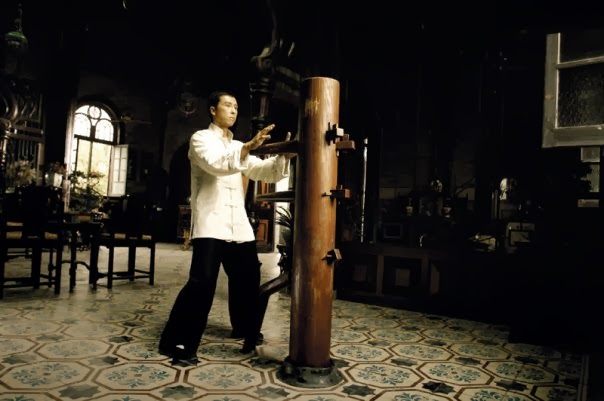
The frame mount version most of us were trained on was developed after Master Ip moved to Hong Kong with the assistance of a carpenter (Fung Shek). Master Ip was no longer wealthy and lived and taught in high rise apartments, so it wasn’t practical to bury a dummy in your floor, as it would be sticking out of the ceiling of your downstairs neighbor.
Different teachers utilize the dummy at different points in the curriculum, but in the Wong Shun Leung lineage, it’s usually introduced at the intermediate stage, somewhere between the Siu Lum Tao and Chum Kiu forms are taught (or just after CK).
I think many people have only learned the system for a year or two and often have not had proper training in the use of this equipment. So they train on it the way they think it should be used, which is often incorrectly and of little use. Yet people are excited by this tool, so they like to film themselves beating on it!
Looks cool, right?
Here is a list of the top 5 mistakes people make in their Wing Chun Wooden Dummy training.
#1 They use the Wooden Dummy to “condition” their arms.
I’ve seen this in person and on the internet. Someone beats the crap out of the dummy, making a lot of noise and causing the dummy to slide wildly on its rails. While this looks (and sounds) impressive, its wrong and a misapplication of time and energy.
Sifu Gary Lam, tells a story about his teacher, Wong Shun Leung (legendary street fighter of Hong Kong). One of Sifu Wong’s students always practiced on the Wooden Dummy with a lot of force. One day, he hit the dummy so hard, one of its arms broke off. “He very happy and then bring the broken arm to my Sifu. Sifu, I did it! I broke the arm!” Wong looked at the student, took the arm and thumped the student on the head with it, and said, “Now we have to buy a new one!”
The idea that you want to “toughen” your arms by hitting the dummy calls to mind the sort of Iron Palm and Iron Body Chi Gung practices of other Chinese fighting systems. This is not the purpose of this equipment in the Wing Chun system.
Wing Chun is a system of deflection .
We use angle to deflect incoming power. This is one of our “secrets.” Wing Chun does not fight power with power. It fights power with re-direction . This is why, as Sifu Lam says above, even if the Wing Chun fighter is an old man, they can still use the fighting technology of the system to overcome a bigger, stronger fighter. The Wing Chun fighter deflects incoming attacks, not intercepting the power but sending the power off at an angle.
This is one of the ways we “let the power go.”
Sifu Gary Lam often used the story of a Mercedes – Honda crash to illustrate this point.

If the little Honda hit the big Mercedes head on, the Honda would “lose.” But, if the Honda hit the Mercedes at an angle (as above), the principles of physics would enhance its force, striking the Mercedes in a weak position.
Sifu Lam always demonstrates this crash with his hands in his demonstrations, but thanks to Youtube, we can see an actual crash in action. I looked around and found this sequence showing a small SUV hitting a big SUV at just the right angle, so that the big SUV is actually flipped out of the way.

This is no fluke – this is physics . This is what you want to do to your opponent!
Its a lot like what happens with a cow catcher . You ever hear of those?
In the mid-1800’s, railroads were having some problems with trains being derailed when they hit debris or even livestock such as cows. An engineer named Charles Babbage invented an apparatus he called a “pilot” but which eventually would become known by everyone else as a “cow catcher.”
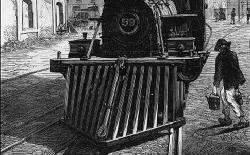
This triangular device would scoop up and/or redirect the debris (or cow) and send it flying off at an angle to the train’s forward direction.
Below is a dramatic demonstration of the power of this concept from the TV show Mythbusters . Note the ease with which those cars and trucks are flung to the side, never once distracting the truck with the cow catcher from its forward course. The energy of the impact actually helps drive the truck back into the ground, enhancing its stability. Wing Chun deflecting actions can also have this effect on your stability.

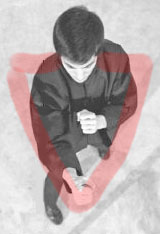 This is what you want to do with the attacks coming toward you – deflect them (but don’t forget to hit at the same time, if possible). And the dummy will train this deflection action into your body, until it becomes reflexive and natural.
This is what you want to do with the attacks coming toward you – deflect them (but don’t forget to hit at the same time, if possible). And the dummy will train this deflection action into your body, until it becomes reflexive and natural.
This is also one of the meanings of our triangular guard. Attacks should be deflected to either side of the guard, just like the cow catcher action.
This is also the meaning of the footwork in the dummy, but in reverse. We flank the opponent’s attack with a sort of triangular footwork (step off the point of their triangle). We move out and then step in at a slightly modified angle.
#2 They think the order of actions is a sequence .
When I took Karate and did Katas, I was told that the movements could be considered a sequence that might be used in a fight. You block and then punch and then kick.
I have my doubts about the effectiveness of this approach. And this is definitely not the meaning of the sequence of actions on the Wing Chun Wooden Dummy.
“The students end up performing their methodical routines as a mere conditioned response rather than responding to “what is.” They no longer listen to circumstances; they recite their circumstances.”
Bruce Lee
We learn the form in a sequence largely because you need to learn one action at a time and the Chinese master’s who developed the system found it useful to string the actions together in a sequence that could be trained many times.
By the time Ip Man reached Hong Kong, after many years of training without any thought for teaching, he’d gone from using the dummy in the order with which he’d been trained by Chan Wah Chun (and others) to using it as a free-form exercise, playing it more as one would play a jazz instrument, improvising actions in a smooth yet random flow.
Once you learn the dummy completely, you can start shuffling the deck as you like, while you work on making your actions more natural and effortless. You don’t want to always train it in the same order forever, or there is a chance you will wire yourself to always follow a technique with the next action in the sequence without thinking . You want reflexes but you want them to be responses to your environment, not drooling for no reason when the bell rings (as with Pavlov’s dogs ).
When Master Ip needed to teach the dummy to his early students (such as Lok Yiu and Wong Shun Leung), they say they saw him awkwardly trying to remember the sequence. He probably never completely succeeded. There is much testimony that he taught the Wooden Dummy in many different ways and orders over the years.
The fact is that the sequence really doesn’t matter, as sequence doesn’t really matter in any Wing Chun form. Each form demonstrates a series of particular movements in particular contexts. But every action is actually a stand-alone lesson and a tool which can be used for various purposes. The order is more or less from the most important (Siu Lum Tao, Chum Kiu, and the first third of the Wooden Dummy) to the less important (Biu Gee, the Knives, and the last secition of the dummy, which are refinements, not fundamentals).
My Sifu likens the techniques of Wing Chun to using a screwdriver. A screwdriver is made to put in or take out screws, but can also be used to punch holes or pry the lid off a paint can. The tools of Wing Chun are designed to be learned one at a time and then utilized creatively, in many circumstances and combinations.
This is why my Sifu often refers to the Tan “shape” or the Fook “shape.” They are techniques but more fundamentally, they are concepts or shapes. The arm can be placed into that general shape and it has certain mechanical properties, but the shape is really a spectrum, along which it can be useful in many variations of the “ideal” shape.
#3 They chase the “hands” of the dummy.
A fundamental principle of the Wing Chun system is that we “chase center.”
What does this mean? It means that we don’t have the idea of blocking in the same way that karate blocks. In Karate, when someone attacks us with a punch, we strike the arm with a block which forcefully swipes to air in front of us and (hopefully) knocks the hand away.
In Wing Chun, we want to make the most of every fraction of a second ( and every degree of angle) so we generally try to always keep our arms heading toward the target. We don’t want to send our hands away from the target, if we can help it.
We always want to be attacking.
In Wing Chun, many of our attacks are also simultaneously defensive actions. Our attacking arm also deflects their incoming strike (changing its angle). Even actions which seem like they are across our body (and not toward the opponent) such as Gan or Kwan often have a quality of chasing the center of the opponent’s body.
Our force goes IN toward their center.
Many students hit the Wooden Dummy as if they are trying to knock away the dummy’s “hands.” We call this “chasing hand.” If I am hitting your hand in a path that leads to one side or the other, this is wrong. We want the hands chasing forward, into the target. This applies to the Pak Saos, the Gan Saos , the Kwan Saos, and nearly every other dummy action.
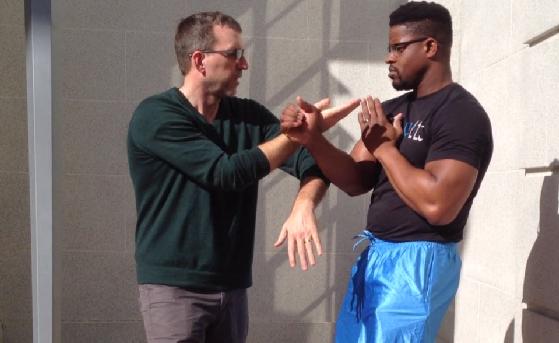
#3 They look down at their hands and feet.
Students often look down at their hands and feet as they practice.
In Wing Chun, this is a big problem. Wing Chun gets power for its attacks through what we call “structure.” Structure is created by maintaining a particular relationship of your limbs to one another and to the body. Most importantly we want our spine to be “straight.” The head has to be up, looking at the target. If you look down, you “break” your structure and lose power. This is because for structure to work, your spine and neck must be straight. You also don’t want to “break” at the hips, not even slightly. If you make your body a unit in the correct manner, you can “borrow” power from the ground to back up the power generated by the forward motion of your body weight.
As soon as you learn the mechanics of a Wooden Dummy action, start trying to do it while looking straight ahead at the center of the dummy. Your power will go where you look.
#4 They don’t use Jeun Ma aka the power generated by their waist.
Many of the dummy actions get their power not only from “the ground” through body structure, but also through the rotational power of Jeun Ma. When we make a “bridge” (contact with the arms of the opponent), we will often use the rotational power of the waist (also linked to the ground) to move the attacking arm “off line.” They are usually reaching or hitting toward our center. We want to deflect this hitting or reaching “line” and turn them off their course by at least 5 or 10 degrees.
How do we rotate them while still chasing center? This is confusing for beginners but it can be done simultaneously with the correct organization of your actions.
You can move your arms forward (linked structurally to your body, i.e., the arms are firm yet supple) and when they intersect with the arm of the opponent, your arm will be pointing slightly away from their center while their arm will be pointing toward your center.
 But your rotational energy (from the turning of the stance and the waist) turns your trunk. The arm is attached to the trunk and is firm in that moment. This creates a great deal of rotational deflecting force, causing their incoming energy to veer off at a slight angle.
But your rotational energy (from the turning of the stance and the waist) turns your trunk. The arm is attached to the trunk and is firm in that moment. This creates a great deal of rotational deflecting force, causing their incoming energy to veer off at a slight angle.
The power of angle is how it multiplies . A light change here magnifies the effect there .
You see in this illustration how a slight change of angle at the inception of the punch will magnify as it travels forward. A slight redirection can cause a punch to miss.
Many dummy actions train and demonstrate this principle. A good example is the Gan Sao – Huen Sao action used many times in the dummy as part of the movement repeated between each section. The Huen Sao will turn the opponent’s attack, changing its incoming angle.
#5 They don’t use their imagination.
This is the big one.
Most students learn the dummy in a rote fashion, struggling to imitate the body position and movements of their instructor in a “monkey see – monkey do” manner. We all start this way. Then (if you are lucky) the instructor will explain how this action might be used in a fight (the first time I “learned” the dummy, there were no explanations). Often, there is more than one explanation – it could be used this way, but also that way, and maybe this way. There are multiple applications of the idea . This is that “screwdriver idea” from above. It can pry but also poke.
You need to imagine that the dummy is a person and consider what your action is doing to their attack.
Which of their arms is coming toward you? Are you on the “inside” or the “outside?” This is an advanced approach to the Wing Chun Wooden Dummy. What is the meaning of the movement?
If you don’t do this, you are wasting your time training the dummy. Going through the motions without understanding won’t prepare you for combat. It is movement divorced from meaning . You might get some cardio benefits but that’s about it.
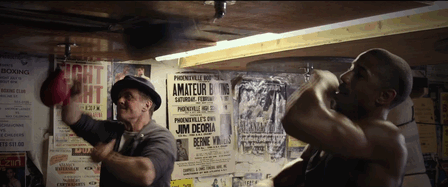
This is using the dummy the way boxers use a speed bag. Boxers don’t hit their opponent with the sequences they use on the speed bag. The speed bag is used to help develop eye-hand coordination, help with rhythm in punches, and train the shoulders to be able to hold up the guard for 12 rounds. If you try and hit an opponent with the speed bag technique, you’ll find it’s not too effective in a real fight.
With the Wing Chun Wooden Dummy, you can’t just go through the motions without thinking. Wing Chun requires thinking and imagination. This goes for all the forms. What does it mean ? If you know what it means, your action will subtly improve. You’ll watch your stability (against the moving attack of the moving opponent). You ground your action. You’ll imagine deflecting their attack with the movement.
One day, while Wong Shun Leung was hitting the wall bag, Master Ip Man said to Leung Sheung, “Look at the way this kid is looking at the wall bag as he hits it … as if he’s hitting a person, not just a bag. I reckon he’ll create a stink in Hong Kong within a year.”
This is the power of visualization and imagination. Wong hit the stationary bag as if it were an opponent . If you do this with all your forms and drills, you will supercharge your Wing Chun!
BONUS POINT
Most people focus on the places where their arms intersect with the dummy. They are hitting at the dummy arms with their arms.
One of the biggest skills the dummy trains (if trained correctly) is the idea the Wing Chun “songs” describe as ” “Sam Yi Hap Yat.” This means something like “mind and body as one.”
A great deal of our system is devoted to helping the fighter to hit with power. This is why we emphasize structure (spine straight, face the opponent squarely, keep the elbows in, step from the waist). These each amplify power and together create a power greater than the sum of its parts. When a master really brings everything together, the resulting power can be shocking.
Several times in the form, there is a very strong demonstration of this principle. You angle off the “point” of the dummy’s “attack” and step in from the side (at about a 45 degree angle) and contact the dummy with a tan and a low palm. You should contact three points on the dummy all at once: the arm (with the tan), the body (with the palm), and the leg (with your leg). You should have good angles on all these shapes, so that you are standing comfortably (slightly tilted back) and you feel the ground with your back heel. There should be a satisfying thump as you solidly contact the dummy with ONE sound.
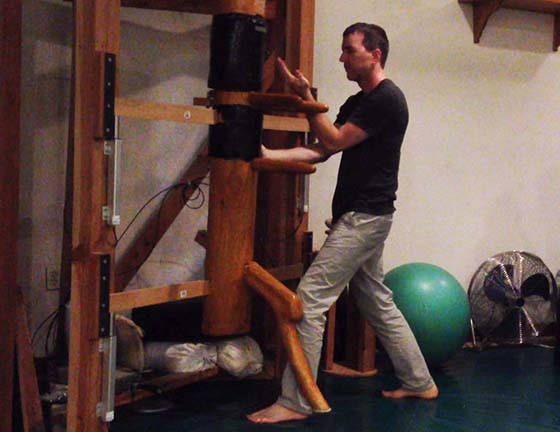
I recommend two videos for learning more about how to use your Wing Chun Wooden Dummy.
Gary Lam’s Complete System of Wooden Dummy .
And David Peterson’s Mook Yan Jong .
Here is Wong Shun Leung doing a version of the complete form.